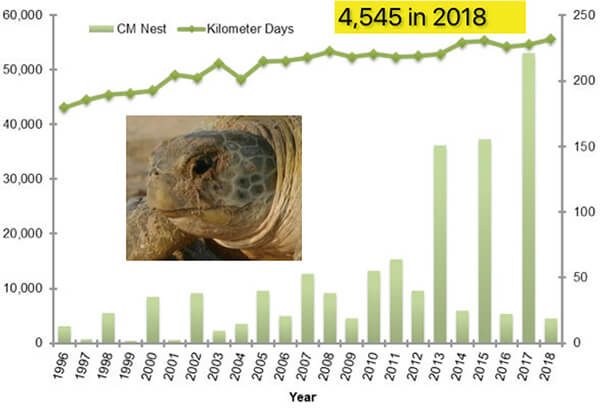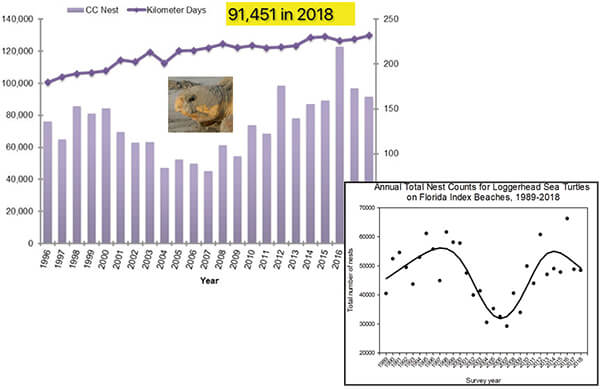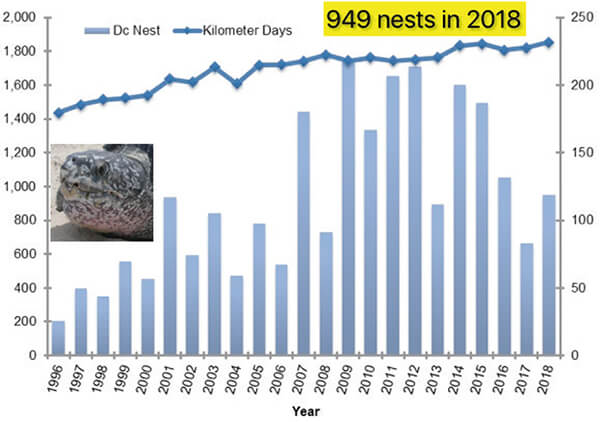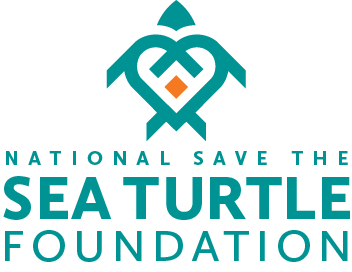2018 Nesting Summary


Florida's beaches are famous for more than one reason... not only are they beautiful, but they are also host to a globally significant number of sea turtle nests each summer. This remarkable natural phenomenon has inspired a virtual army of turtle enthusiasts accomplish what would otherwise be an overwhelming task for our State environmental agencies: From professional biologists to retired volunteers, nearly 3,000 people from all around the State of Florida participate in organized sea turtle nesting counts that are critical to answering one of our most commonly asked questions: How are the turtles doing?
One of the big challenges of conserving any long lived, wide-ranging marine creature is knowing how many there actually are. We can't easily count them to estimate population numbers, and generation times can often match ours, so it takes a long time to recognize either a recovery or a decline in a population that we may be interested in studying. Lucky for us, sea turtles need to return to land to nest, so there's a relatively easy way for us to keep track of population trends through careful documentation of each

“Green turtle nesting in Florida is interesting in two ways. First, there seems to be a burgeoning population of females using Florida as nesting grounds, so it looks as if green turtles are responding well to long-term regional conservation efforts. Second, they have a unique and conspicuous bi-annual pattern of nesting activity. If the pattern holds, there may be another record set in 2019!”
species' reproductive effort over time. Of course, there are limitations; e.g. only females come ashore, and we don't get a total 'count' of the number of individuals actually involved each year because each female may nest multiple times, but we're mostly interested in how each population is doing, and careful nest counts have proven to be a very useful proxy for studying sea turtle population trends.
In Florida, there are three species of sea turtle that nest each year with any regularity; the loggerhead, green, and leatherback turtles. Of particular interest to Florida's sea turtle scientists are the impressive numbers of loggerhead turtle nests that are documented each year, which can exceed 100,000. Because this reproductive effort represents ~90% of the entire northwest Atlantic loggerhead population, the data collected on loggerhead turtles in Florida are especially meaningful for the preservation of this species in the Atlantic Ocean.

“Florida's loggerhead turtle nest counts have fluctuated from year to year and even decade to decade. However, long-term data are critical to understanding population trends, and it appears the loggerhead nesting population has remained fairly stable since the early 1990's.”
Thanks to nearly two decades of data, we see encouraging signs that the population, though it may have 'ups' and 'downs', is fairly stable, and hopefully continues to have success in this extremely important rookery.
For the greens and leatherbacks, Florida is only one of many nesting sites around the Caribbean, but still has important significance in maintaining the region's genetic diversity for both of these species. Green turtles come in second after the loggerheads in overall nest production in Florida, and in some locations actually produced more nests per kilometer than loggerheads over the last few years. Though no one knows why for sure, female green turtles have somehow synchronized their nesting activity to form a dramatic bi-annual pattern of high vs. low productivity, allowing us to 'expect' high or low years. For those who count nests, 2019 should be a doozie!
Leatherback turtles come in third on the list of Florida's nesters, certainly not for any other reason than they, comparatively, have a much smaller nesting population; notice the scale on the leatherback nesting chart is in the hundreds, not thousands. Leatherbacks are amazing giants that have begun to take Florida a little more seriously as a nesting site since around the year 2000, but remain somewhat of a mystery concerning nesting trends with lots of annual variation that doesn't seem to yet form a pattern. Either way, we wish them the best, and we hope the more recent declines are just a temporary glitch in a long-term positive trend.
Many thanks to the Florida Fish and Wildlife Conservation Commission for providing the data and charts.
Helping Sea Turtles Survive for 39 Years
A NON-PROFIT ORGANIZATION
State of Florida Registration Number CH-2841 | Internal Revenue Code 501 (c) (3)
Web Design & Development by Web Expressions, LLC

